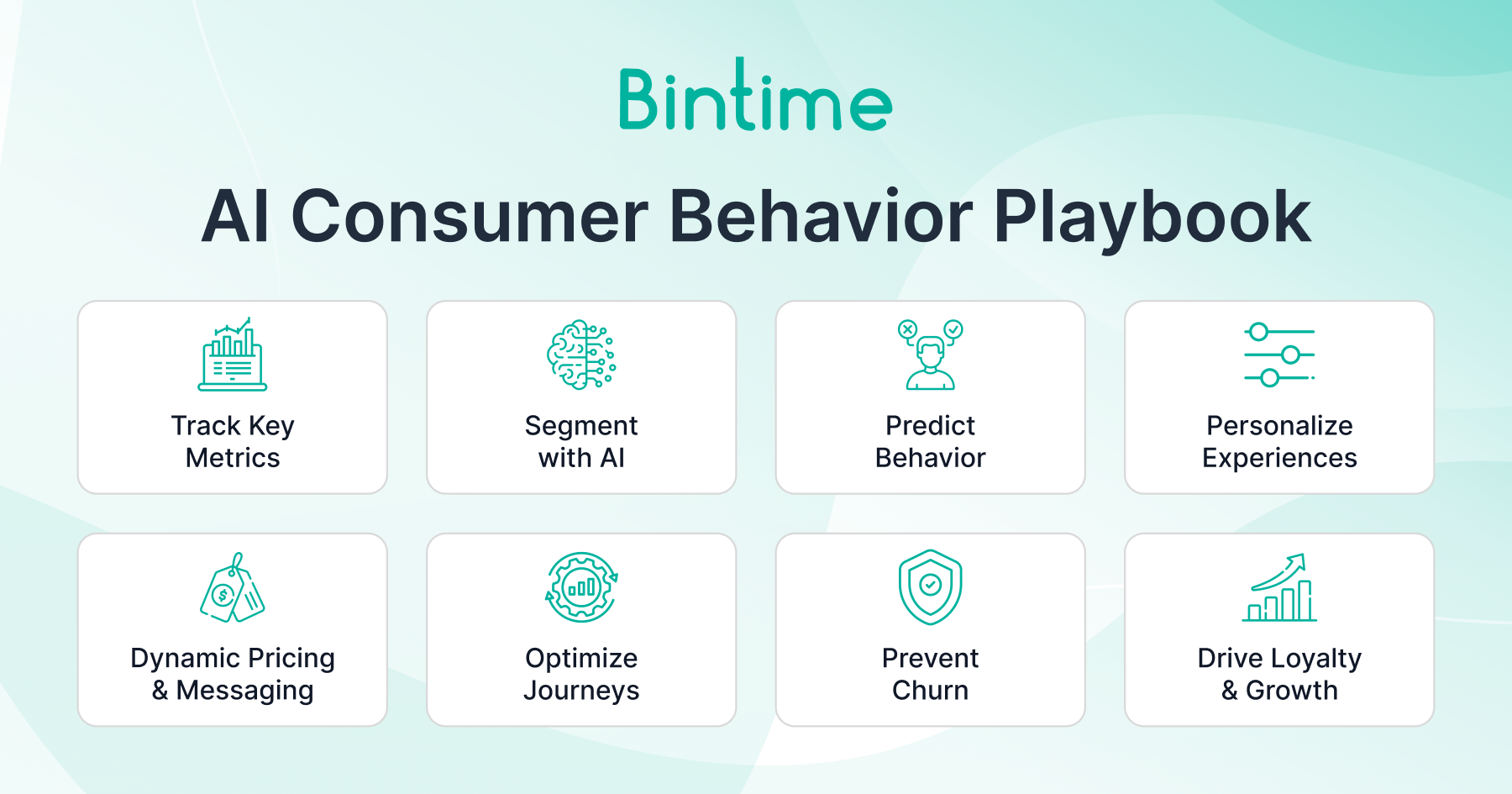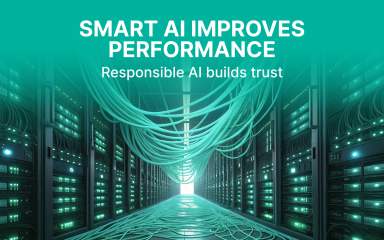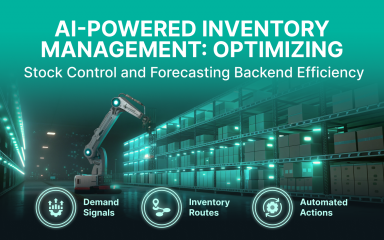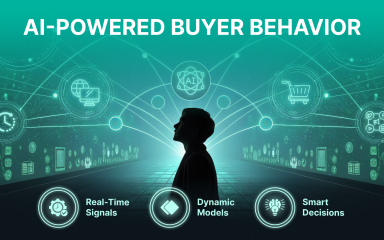From Consumer Habits to Market Decisions: How AI Shapes the Consumer Model, Buyer Behavior
Why Consumer Behavior is the New Battleground
You know how every click online seems tracked? That’s not just analytics—it’s AI working behind the scenes. In today’s eCommerce, the real battleground isn’t price or product—it’s understanding the behavior of customers in real time.
Here’s what you’ll learn:
- How AI refines the consumer model to predict market behavior.
- Why analyzing consumer habits leads to better personalization.
- How customer analysis reveals unseen opportunities.
- Where buyer behavior models drive smarter segmentation.
Think about it: businesses that can analyze user behavior at scale don’t just react to customers—they influence them. McKinsey reports that companies using AI-driven customer models see a 10–20% lift in customer satisfaction and up to a 15% increase in revenue growth compared to competitors who don’t [McKinsey, 2023].
“AI turns raw user behavior data into actionable insights—personalization, segmentation, and predictive analytics are no longer optional; they’re the baseline.”
The shift is clear: consumer habits aren’t just patterns—they’re signals that AI can decode. And in a crowded eCommerce market, your ability to capture those signals determines whether you lead—or lag behind.
AI Customer Models & Buyer Behavior Frameworks
A buyer behavior model—sometimes called a customer model—is the framework businesses use to understand how and why people make purchasing decisions. Traditional models like the Engel-Kollat-Blackwell (EKB) model or the Buyer Decision Process (BDP) map out steps such as need recognition, information search, evaluation, purchase, and post-purchase behavior. They’re powerful as theory, but in practice, they’ve long relied on surveys, focus groups, and limited transaction data.
AI has changed that. Today’s customer analysis isn’t confined to static assumptions—it’s driven by live user behavior data. Instead of guessing when a consumer might compare options or delay a purchase, AI can analyze the consumer in real time, capturing clicks, dwell time, cart actions, and even subtle browsing habits. This creates a dynamic consumer model that updates continuously with each interaction.
Here’s how AI evolves these models:
- From static to real-time: Rather than treating consumer habits as historical records, AI refreshes insights instantly.
- From assumptions to data-driven: Buyer analysis no longer depends on broad psychological theory alone; it fuses behavioral science with high-volume user behavior data.
- From generic to segmented: AI clustering groups customers by patterns like urgency (buy now vs. delayed purchase), decision inertia (hesitation vs. fast action), and brand affinity (loyalist vs. switcher).
💡 Use Case: Predictive Cart Abandonment Segmentation
Imagine an eCommerce store where 60% of customers abandon their carts. A traditional buyer behavior model might suggest that shoppers are weighing alternatives or feeling uncertain about price. But AI goes deeper. By analyzing user behavior data—time spent on product pages, number of visits before checkout, or frequency of discount-code searches—AI can classify shoppers into distinct segments:
- Price-sensitive browsers likely to return if nudged with discounts.
- Indecisive shoppers who need reassurance via reviews or social proof.
- Impulse buyers at risk of distraction, requiring real-time reminders.
Instead of treating cart abandonment as a single problem, AI enables predictive segmentation. The result? A brand can automate personalized interventions—like sending tailored emails, adjusting UX flows, or triggering limited-time offers—to influence consumers directly.
This shift from theory to AI-driven customer analysis means businesses can refine their strategies in hours, not months. By embedding AI into buyer behavior models, eCommerce leaders unlock not just understanding—but the power to act instantly on the behavior of customers.
Interpreting Consumer Data: From Metrics to Meaning
 Raw data by itself doesn’t drive growth—the meaning behind the metrics does. In eCommerce, analyzing user behavior across platforms has become the cornerstone of modern customer analysis. AI doesn’t just count clicks; it reads signals, connects them, and transforms them into business outcomes.
Raw data by itself doesn’t drive growth—the meaning behind the metrics does. In eCommerce, analyzing user behavior across platforms has become the cornerstone of modern customer analysis. AI doesn’t just count clicks; it reads signals, connects them, and transforms them into business outcomes.
Key Metrics That Matter
- Session Time – How long a customer spends on a site or app.
- Clickstream – The navigation path a user follows across pages.
- Dwell Time – How long a user stays on a specific page or product.
- Scroll Depth – How far a visitor scrolls, signaling content engagement or drop-off.
Individually, these metrics offer fragments of insight. Together, when processed by AI, they evolve into a dynamic customer model that reveals habits, intent, and even purchase probability.
How AI Creates Meaning
AI connects user behavior data from multiple touchpoints—desktop, mobile app, email clicks, social ads—and merges them into a single client analysis framework. This cross-channel intelligence allows AI to:
- Flag risks (e.g., repeated visits without purchase → potential churn).
- Identify opportunities (e.g., high dwell time on premium items → upsell potential).
- Enhance personalization logic (e.g., reordering product recommendations to match browsing behavior).
Mini Case: Predictive Conversion Score
A retail brand integrates AI to assign a conversion probability score to each visitor. A shopper who spends 5+ minutes on product pages, scrolls to the bottom, and returns within 48 hours might be scored at 75% likelihood to convert. This enables automated retargeting: tailored emails, timely discounts, or even AI-powered chat nudges. In one pilot, businesses using predictive scoring increased conversions by 12–15% within a quarter.
Signal → Insight → AI Action → Result
| Signal (Behavior) | Insight | AI Action | Result |
| Long session time but no checkout | Browsing interest, possible hesitation | Trigger personalized pop-up with FAQ/reviews | Reduced decision inertia, higher trust |
| High dwell time on premium products | Strong purchase intent | Push upsell/cross-sell recommendations | Higher average order value |
| Shallow scroll depth on product page | Low engagement | Optimize layout or highlight key info earlier | Increased page stickiness |
| Repeated cart abandonment | Price sensitivity or distraction | Send discount code, retarget with urgency | Improved cart recovery rate |
| Complex clickstream with many returns | Confusion in navigation | Simplify UX flow, adjust CTAs | Better customer experience, reduced drop-offs |
AI-driven customer analysis transforms these scattered signals into actionable strategies. It’s not just about tracking the behavior of customers—it’s about decoding them in real time to influence outcomes.
How AI Personalizes the Experience Based on Habits
Personalization isn’t just a buzzword anymore—it’s the backbone of modern eCommerce. When businesses can analyze user behavior and align with consumer habits, every touchpoint becomes an opportunity to convert intent into action. AI takes the traditional customer model and supercharges it with real-time decision-making, allowing brands to shape discovery, pricing, and outreach at scale.
Behavioral-Based Recommendation Engines
Product discovery is no longer left to chance. AI-driven recommendation engines analyze buyer behavior models—what a shopper clicks, how long they dwell, what they ignore—and generate highly relevant suggestions. For example, if a customer spends time browsing hiking gear, AI won’t just recommend tents; it might surface eco-friendly apparel or gear bundles that align with their consumer habits.
Smart Pricing and Offer Personalization
Pricing is one of the clearest signals to influence consumers. AI continuously monitors market behavior and user-level actions to adjust offers dynamically. If a shopper repeatedly views a product without purchasing, the system can trigger a limited-time discount.
Search Result Reordering & Channel Timing
AI also reshapes how products appear. Instead of generic sorting by popularity, AI reorders search results based on individual browsing history and behavioral signals. At the same time, outreach is optimized by timing: an indecisive shopper might get a push notification after a browsing session, while a morning shopper receives tailored deals before commute hours.
Use Case: Eco-Conscious Shopper
Consider an eco-conscious customer browsing sustainable sneakers. AI detects patterns in user behavior data: clicking only on products marked “sustainable,” scrolling deeper on green-certified items, and abandoning carts with non-sustainable options. Over time, the system learns this behavior of customer and reshapes the experience:
- Product discovery: Recommend only eco-friendly sneakers and accessories.
- Smart pricing: Provide weekend-only deals on recycled-material products.
- Outreach timing: Send Saturday morning emails highlighting sustainability bundles, when the customer’s engagement history shows peak activity.
The result? Not just a transaction, but a tailored journey that reinforces brand loyalty. Businesses that integrate these AI-powered personalization strategies see up to 20% sales uplift compared to those relying on static personalization [Boston Consulting Group, 2023].
AI personalizes at scale by converting consumer habits into hyper-relevant experiences. It’s how the theory of the buyer behavior model becomes living, breathing commerce.
Influence of Consumer Behavior on Pricing & Messaging
Pricing and messaging are no longer static—they shift with every signal the behavior of customers provides. AI enables businesses to move beyond broad assumptions and build agile strategies that adapt in real time to individual users, market conditions, and even emotional triggers.
Dynamic Pricing: Beyond Discounts
Traditional pricing strategies relied on seasonal cycles or blanket promotions. With AI-driven customer analysis, brands can create dynamic pricing models that respond to both user history and competitor activity. For example, if a shopper repeatedly visits the same product page without converting, AI can flag high intent but possible price resistance.
Microcopy That Matches the Buyer
Behavioral AI also transforms how brands communicate. Instead of generic calls-to-action, AI-powered models adjust messaging and CTAs based on psychographic profiles and consumer habits. An indecisive shopper may see a copy that emphasizes reassurance (“Trusted by 10,000+ buyers”), while an impulse-driven customer receives urgency cues (“Only 2 left—order now!”). This personalization is rooted in the buyer behavior model but enhanced with live data from user behavior analysis.
Tone, Urgency, and Social Proof
AI doesn’t just write messages; it chooses the tone that resonates. By analyzing dwell time, clickstream, and scroll depth, the system can infer levels of trust or hesitation. For a new visitor, it might highlight reviews or guarantees. For a repeat visitor, it may reduce friction with faster checkout copy. In each case, the AI aligns microcopy with the user’s mindset, converting insights into influence.
Mini Case: Price Sensitivity & Trust
Imagine a brand selling smart home devices. AI detects two user segments:
- Price-sensitive browsers who abandon carts when no discount is offered.
- Trust-driven shoppers who spend more time reading product guarantees.
By combining dynamic pricing with adaptive microcopy, businesses can influence consumers in ways that feel natural yet data-driven. The outcome isn’t just higher sales—it’s a scalable strategy grounded in the market behavior of each customer.
Conclusion: Behavior-Driven Commerce Is the Future
Before AI, eCommerce teams relied on surveys, assumptions, and delayed actions. Personalization was surface-level, based on broad psychographic guesses, and decisions often arrived too late to capture demand.
With AI, the game has changed. Every session time, clickstream path, and dwell pattern feeds into live customer analysis. Instead of generic offers, shoppers now experience tailored journeys at scale. Pricing adapts dynamically, microcopy shifts in real time, and predictive insights guide decisions before the customer even hesitates.
The difference is speed, depth, and accuracy:
- Decision-making moves from reactive to instant.
- Personalization evolves from “one-size-fits-all” to hyper-relevant.
- Predictions grow sharper with every behavior signal processed.
In short, behavior-driven commerce is the new standard. Personalization = precision = profit. Brands that harness AI to decode consumer habits and buyer behavior models won’t just keep up with the market—they’ll shape it.











